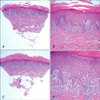INTRODUCTION
Lichen planus (LP) is a unique inflammatory disorder of unknown etiology that affects the skin, mucous membranes, nails and hair. It is characterized by violaceous, scaly, flat-topped, polygonal papules commonly involving the flexural areas of the wrists, legs, and oral and genital mucous membranes of those 30~60 years old, but it is uncommon in children1-3. According to the literature, LP on the palms and/or soles occurs rarely and does not usually have classical clinical features4. Only a few cases of LP on the palms and soles in pediatric patients have been reported in the literature3. Here we report an interesting case of childhood LP with palmoplantar involvement.
CASE REPORT
The patient was a 7-year-old boy who had various sized and shaped, flat-topped, erythematous to violaceous, grouped and confluent polygonal papules with white-grayish striae on the whole body for 6 months. In addition, he complained of intense itching. The lesions started as pruritic papules on the right knee and gradually spread to the whole body including the palms and soles (Fig. 1). These lesions were bilateral but asymmetrical. The palmoplantar lesions were erythematous scaly plaques and the surfaces were not shiny, Wickham's striae were not observed. The scalp, mucous membranes and nails were not involved. Koebner's phenomenon occurred on the traumatized skin. He had no history of concomitant drug intake, infection, vaccination, or other putative trigger factors, and there was no family history of similar skin disease. Routine laboratory tests including complete blood count, blood chemistry analysis, and urinalysis were normal. The results of screening for hepatitis B and C viruses were negative. The skin biopsy specimens were taken from four sites of the patient (dorsum of the hand, dorsum of the foot, sole and chest). On histopathological examination, the specimen showed basal cell degeneration with a band-like lymphocytic infiltrate in the upper dermis along with focal hypergranulosis and irregular acanthosis (Fig. 2). A diagnosis of generalized lichen planus with palmoplantar involvement was made based on clinical and histological features. We started treatment with oral anti-histamines, topical steroids and 1% pimecrolimus cream. After 2 months, the skin lesions were in complete remission. After one year follow up, there was no evidence of recurrence.
DISCUSSION
LP is a relatively common disease in adults. The overall prevalence is believed to be somewhat less than 1 percent of the general adult population. It is less common in children1. Population-based epidemiologic data on the prevalence of LP in children are not available and only a few groups have published series of childhood LP cases that include more than 15 patients2,3,5,6. As in the adult population, the classical variant of LP with a localized cutaneous lesion was the most common clinical type (58~70%) in pediatric LP patients as well, whereas mucosal and nail involvement was detected to a far lesser extent2,4. According to the literature, involvement of the palms and/or soles in LP is uncommon, and mainly appears between the third and fifth decade1,7. The involvement of the palms and/or soles in LP is even more uncommon in the pediatric age group. Recently, Handa and Sahoo3 found 2 cases (2.3%) of LP with palmoplantar involvement in their study of 87 children with LP. Our patient showed generalized LP with palmoplantar involvement, a less frequent clinical subtype with only a few reports of affected children published to date.
The palmoplantar lesions do not usually have the classically described clinical morphology, making it difficult to diagnose. Several morphological patterns of palmoplantar lesions in LP have been described: erythematous plaques, punctate keratosis, diffuse keratoderma and ulcerative lesions. The apparent absence of Wickham's striae may be because the thickness of the horny layer obscures observation of the localized thickening of the granular layer, which is the histopathological correlate of these structures. The palmoplantar LP showed a characteristic histopathology, very similar to that described for other sites. As the clinical features may not suggest LP, a biopsy is extremely useful7.
Various precipitating factors are known to play an important role in the pathogenesis of LP. These include drugs, vaccinations and viral infections. A possible role of infection and vaccination in triggering LP has been repeatedly suggested over the years, in particular chronic active hepatitis C infection and immunization against hepatitis B virus1,2,4. However, no obvious precipitating factors could be elicited in our patient.
To date, due to a lack of controlled clinical trials, no consensus exists regarding standardized therapy regimens for generalized LP in childhood. Still, effective treatment of this highly pruritic skin condition is mandatory to effectively suppress pruritus and to quickly restore quality of life. A short course of systemic steroids has been used in children to control eruptive, widespread disease. Psoralen and ultraviolet A (PUVA) light photochemotherapy and narrowband UVB have been successfully used in adult LP patients1,4. A recent clinical report indicates that topical tacrolimus might be an effective treatment alternative in the management of patients with generalized lichen planus8.
To the best of our knowledge, ours is the first report of a case of childhood LP with palmoplantar involvement in Korea. LP should be considered in the differential diagnosis of polygonal papules and plaques on the whole body including palms and/or soles. Considering the great number of LP variants, clinicians should distinguish childhood LP from other papulosquamous skin diseases such as lichen nitidus, lichen striatus, childhood papular acrodermatitis, and pityriasis lichenoides.




 PDF
PDF ePub
ePub Citation
Citation Print
Print




 XML Download
XML Download